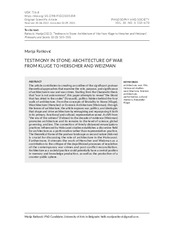Testimony in Stone: Architecture of War from Kluge to Herscher and Weizman
Svedočenje u kamenu: arhitektura rata od Klugea do Heršera i Vajcmana
| dc.creator | Ratković, Marija | |
| dc.date.accessioned | 2022-10-26T08:56:56Z | |
| dc.date.available | 2022-10-26T08:56:56Z | |
| dc.date.issued | 2022 | |
| dc.identifier.issn | 0353-5738 | |
| dc.identifier.uri | http://rifdt.instifdt.bg.ac.rs/123456789/2689 | |
| dc.description.abstract | The article contributes to creating an outline of the significant postwar theoretical approaches that examine the role, purpose, and significance of architecture in war and war crimes. Starting from the Clausewitz thesis that “war is not autonomous”, this paper attempts to reveal “the blood that has dried in the codes” (Foucault), politics hidden behind the four walls of architecture. From the concepts of Brutality in Stone (Kluge), Warchitecture (Herscher) or Forensic Architecture (Weizman), through the lenses of architecture, the article exposes war, politics, and ideologies that shape and drive architecture by reimagining and repurposing it both in its primary, functional and cultural, representative sense. A shift from “the era of the witness” (Felman) to the decade of evidence (Weizman) promotes architecture and its remains to the level of science, global governing, and law. The connection of timely-distanced emancipatory practices influenced by Holocaust studies establishes a discursive field for architecture as a performative rather than representative practice. The theoretical frame of the postwar landscape as second nature (Adorno) is crucial for discussing the role of architecture in the Holocaust. Furthermore, it stresses the work of Herscher and Weizman as a contribution to the critique of the depoliticized processes of resolution of the contemporary war crimes and post-conflict reconciliation. Architecture as a societal practice could potentially have a central position in memory and knowledge production, as well as the production of a counter-public sphere. | sr |
| dc.description.abstract | Svedočenje u kamenu mapira značajne posleratne teorijske pristupe koji ispituju ulogu, namenu i važnost istraživanja arhitekture rata i ratnih zločina. Polazeći od Klauseviceve teze da rat nije autonoman, tekst pokušava da otkrije „krv koja se osušila u kodeksima zakona“ (Fuko), politike skrivene “u svoja četiri zida” arhitekture. Kroz koncepte „brutalnosti u kamenu“ (Kluge), arhitekture rata (Heršer) i forenzičke arhitekture (Vajcman), kroz prizmu arhitekture – rad izlaže rat, politike i ideologije koje su oblikovale i usmerile arhitekturu preoblikujući i prenamenjujući je i u primarnom – funkcionalnom, ali i u kulturalnom, reprezentativnom smislu. Pomak od „dekade svedoka“ (Felman) do dekade dokaza (Vajcman) arhitekturu i njene ostatke čini osnovom nauke, globalnog upravljanja i zakona. Povezivanjem vremenski udaljenih emancipatornih praksi nastalih pod uticajem studija Holokausta, formira se diskurzivno polje za mišljenje arhitekture i kao performativne, a ne isključivo reprezentativne prakse. Teorijski okvir posleratnog pejzaža kao „druge prirode“ (Adorno) je ključni za razumevanje uloge arhitekture unutar Holokausta. Posebno se ističe i rad Heršera i Vajcmana u kritici depolitizovanih procesa rešavanja ratnih zločina i postkonfliktnih politika pomirenja. Arhitektura kao društvena praksa može imati centralno mesto u proizvodnji znanja i sećanja, kao i u stvaranju kontrajavne sfere (Kluge). | sr |
| dc.language.iso | en | sr |
| dc.publisher | Beograd : Institut za filozofiju i društvenu teoriju | sr |
| dc.rights | openAccess | sr |
| dc.rights.uri | https://creativecommons.org/licenses/by-nc-nd/4.0/ | |
| dc.source | Filozofija i društvo / Philosophy and Society | sr |
| dc.subject | architecture | sr |
| dc.subject | war | sr |
| dc.subject | film | sr |
| dc.subject | Holocaust studies | sr |
| dc.subject | warchitecture | sr |
| dc.subject | forensic architecture | sr |
| dc.subject | performative | sr |
| dc.subject | cultural memory | sr |
| dc.subject | Alexander Kluge | sr |
| dc.title | Testimony in Stone: Architecture of War from Kluge to Herscher and Weizman | sr |
| dc.title | Svedočenje u kamenu: arhitektura rata od Klugea do Heršera i Vajcmana | sr |
| dc.type | article | sr |
| dc.rights.license | BY-NC-ND | sr |
| dc.citation.issue | 3 | |
| dc.citation.volume | 33 | |
| dc.citation.spage | 535 | |
| dc.citation.epage | 550 | |
| dc.identifier.doi | 10.2298/FID2203535R | |
| dc.type.version | publishedVersion | sr |
| dc.identifier.fulltext | http://rifdt.instifdt.bg.ac.rs/bitstream/id/9382/bitstream_9382.pdf |

